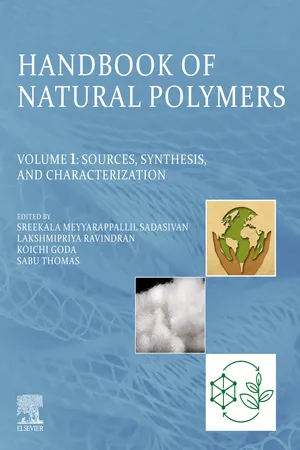
Handbook of Natural Polymers, Volume 1
Sources, Synthesis, and Characterization
- 700 pages
- English
- ePUB (mobile friendly)
- Available on iOS & Android
Handbook of Natural Polymers, Volume 1
Sources, Synthesis, and Characterization
About This Book
The Handbook of Natural Polymers: Sources, Synthesis, and Characterization is a comprehensive resource covering extraction and processing methods for polymers from natural sources, with an emphasis on the latest advances.
The book begins by introducing the current state-of-the-art, challenges, and opportunities in natural polymers. This is followed by detailed coverage of extraction, synthesis, and characterization methods, organized by polymer type. Along with broad chapters discussing approaches to polysaccharide-based polymers, dedicated chapters offer in-depth information on nanocellulose, chitin and chitosan, gluten, alginate, natural rubber, gelatin, pectin, lignin, keratin, gutta percha, shellac, silk, wood, casein, albumin, collagen, hemicellulose, polyhydroxyalkanoates, zein, soya protein, and gum. The final chapters explore other key themes, including filler interactions and properties in natural polymer-based composites, biocompatibility and cytotoxicity, biodegradability, life cycle, and recycling. Throughout the book, information is supported by data, and guidance is offered regarding potential scale-up and industry factors.
As part of a 3-volume handbook offering comprehensive coverage of natural polymers, this book will be of interest to all those looking to gain a broad knowledge of natural polymers, including academic researchers, scientists, advanced students, engineers, and R&D professionals from a range of disciplines and industries.
- Provides systematic coverage of the latest methods for the extraction, synthesis, and characterization of natural polymers.
- Includes an extensive range of natural polymer sources, including established biopolymers and emerging materials.
- Explores preparation of natural polymers and their composites, blends, IPNs, gels, and nanoparticles.
Frequently asked questions
Information
Table of contents
- Cover image
- Title page
- Table of Contents
- Copyright
- Contributors
- Preface
- Chapter 1. The state of the art of biopolymers-new challenges, opportunities, and future prospects
- Chapter 2. Extraction and classification of starch from different sources: Structure, properties, and characterization
- Chapter 3. Starch as a promising replacement for synthetic polymers
- Chapter 4. Recent studies on starch-based materials: Blends, composites, and nanocomposites
- Chapter 5. Recent perception into the extraction of nanocellulose: cross talk between natural resources and progressive applications
- Chapter 6. Extraction of chitin, preparation of chitosan and their structural characterization
- Chapter 7. Chitin and chitosan-based polymer blends, interpenetrating polymer networks, and gels
- Chapter 8. Antibacterial efficacy of natural compounds chitin and chitosan: a mechanistic disclosure
- Chapter 9. Anisotropic nanoscale green materials: prior and current status of nanocellulose and nanochitin systems
- Chapter 10. Grafted natural polymers: synthesis and structure–property relationships
- Chapter 11. Isolation of gluten from wheat flour and its structural analysis
- Chapter 12. Extraction of alginate from natural resources
- Chapter 13. Physical and chemical impact of nanoparticle-reinforced alginate-based biomaterials
- Chapter 14. Natural rubber-based micro- and nanocomposites
- Chapter 15. Isolation and structural evaluation of pectin, pectin-based polymer blends, composites, IPNs and gels
- Chapter 16. Extraction, properties, and applications of keratin-based films and blends
- Chapter 17. Silk-based natural biomaterials: Fundamentals and biomedical applications
- Chapter 18. Wool, a natural biopolymer: extraction and structure–property relationships
- Chapter 19. Extraction and properties of casein biopolymer from milk
- Chapter 20. Collagen - a highly developed and abundant fibrous protein: synthesis and characterization
- Chapter 21. Bioconversion of waste to polyhydroxyalkanoates—A circular bioeconomic approach
- Chapter 22. Sources, extraction, and characterization of zein
- Chapter 23. Isolation, characterization, and industrial processing of soybean proteins
- Chapter 24. Extraction and physicochemical characterization of exudate gums
- Chapter 25. Extraction and physicochemical characterization of gum
- Chapter 26. Natural biopolymers combined with metallic nanoparticles: a view of biocompatibility and cytotoxicity
- Index